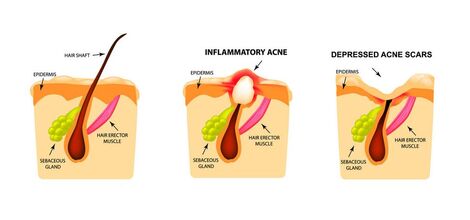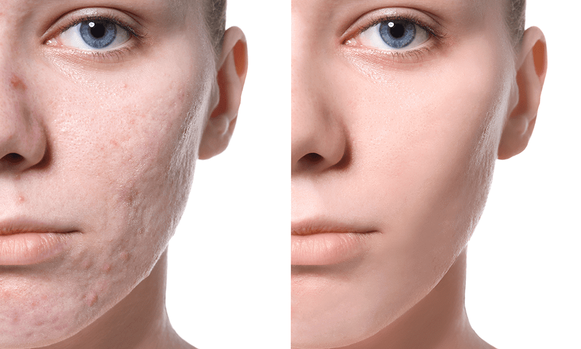|
Treatment pricing
Starting at $169 |

When an acne breakout develops, your skin becomes inflamed as part of your body’s self-defense mechanism. However, when the inflammation gets too severe, the chances of a scar developing increase. Mild inflammation easily becomes severe inflammation and ultimately rupture of the wall of the hair follicle. Once the acute inflammation clears, you are left with a permanent skin depression or elevation in your skin. This often occurs when you pick at whiteheads and blackheads or when the breakouts consist of pus-filled pimples or nodules.
Scars may come in numerous forms, shapes, and pigmentation - they can appear in different shades of pink, red, grey or brown, or they can be raised or depressed in texture. The texture of the scarred area is different than the smooth, surrounding skin.
Scars may come in numerous forms, shapes, and pigmentation - they can appear in different shades of pink, red, grey or brown, or they can be raised or depressed in texture. The texture of the scarred area is different than the smooth, surrounding skin.

Types of Acne scars:
Rolling scar - sloping edges and give the skin a wavy uneven appearance
Boxcar scar - wider than icepick scars, more oval in shape and not as deep
Icepick scars - deeper skin indentations that extend through the dermis and epidermis
Hypertrophic scars - these are thick and raised scars common to the chest and back
You can significantly decrease the chances of scarring from acne by taking care of your skin early. Developing good habits such as resisting the urge to pick at blemishes, wearing sunscreen, and applying medicated cream are key factors to help prevent acne scar formation. There are many options for treatment, based on scientifically-established acne guidelines.
Rolling scar - sloping edges and give the skin a wavy uneven appearance
Boxcar scar - wider than icepick scars, more oval in shape and not as deep
Icepick scars - deeper skin indentations that extend through the dermis and epidermis
Hypertrophic scars - these are thick and raised scars common to the chest and back
You can significantly decrease the chances of scarring from acne by taking care of your skin early. Developing good habits such as resisting the urge to pick at blemishes, wearing sunscreen, and applying medicated cream are key factors to help prevent acne scar formation. There are many options for treatment, based on scientifically-established acne guidelines.

Treatment
Acne scar treatment consists of many local and systemic treatments. Laser resurfacing, fillers, medical grade chemical peels can all be used to treat acne scars. These are all dermatological treatments prepared individually. What is key to the success of your treatment plan will be accurately identifying the cause of your acne and then apply the appropriate treatment.
During your consultation, we will carefully examine and evaluate your skin and determine the possible cause of acne in addition to reviewing all and any treatments you have tried. Together we will formulate a detailed plan to address your skin concerns.
- Chemical peels
- Microneedling
- Retinoids
- Oral contraceptives
- Corticosteroids
- LED phototherapy
- Laser Resurfacing
Acne scar treatment consists of many local and systemic treatments. Laser resurfacing, fillers, medical grade chemical peels can all be used to treat acne scars. These are all dermatological treatments prepared individually. What is key to the success of your treatment plan will be accurately identifying the cause of your acne and then apply the appropriate treatment.
During your consultation, we will carefully examine and evaluate your skin and determine the possible cause of acne in addition to reviewing all and any treatments you have tried. Together we will formulate a detailed plan to address your skin concerns.


